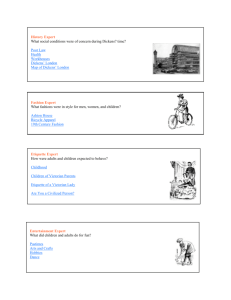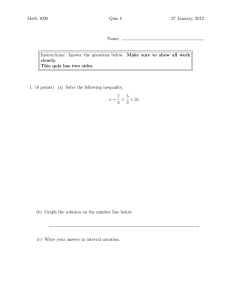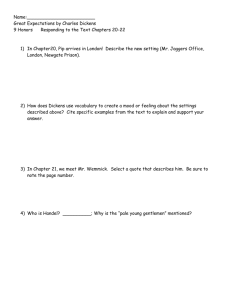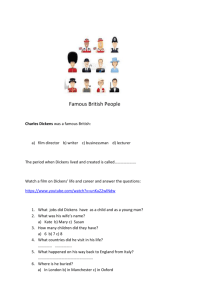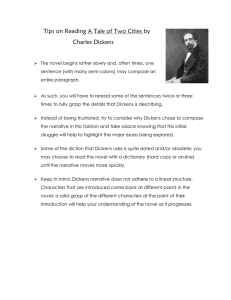Great Expectations A man of
advertisement
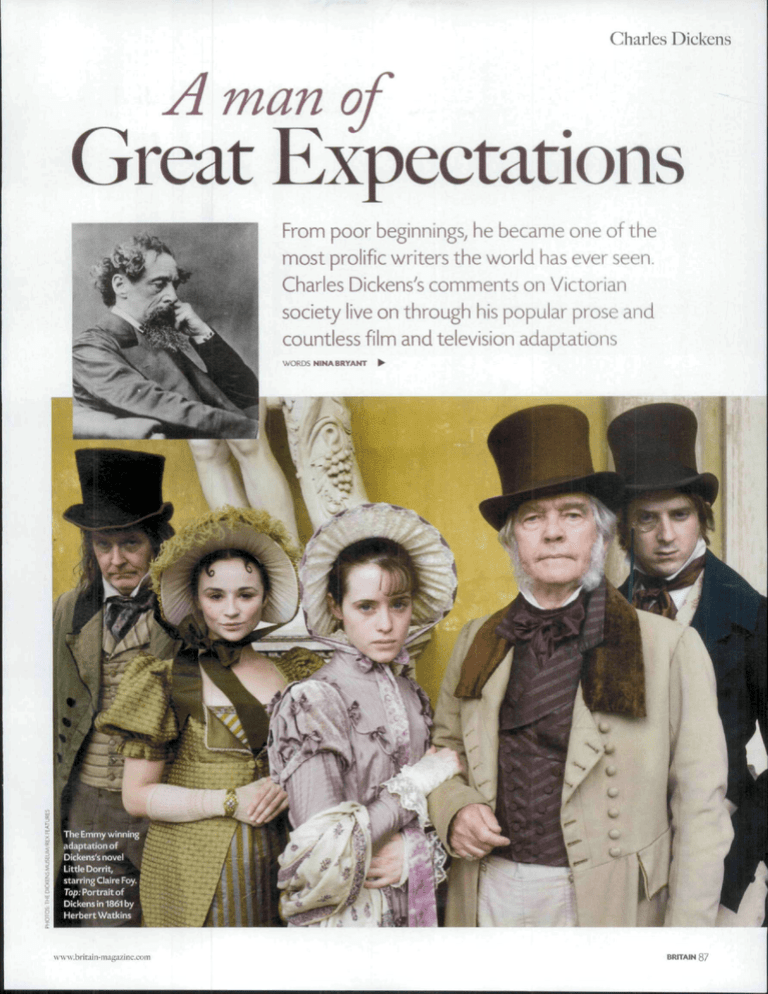
Charles Dickens A man of Great Expectations From poor beginnings^ he became one ofthe most prolific writers the world has ever seen. Charles Dickens's comments on Victorian society live on through his popular prose and countless film and television adaptations w v\ .briwi n-magazi nc.com BRITAIN 87 T "^here is arguably no period in British history that has had as great an impact on the way we live our lives today than the Victorian era. The reign of Queen Victoria saw an incredible shift in society unlike any before or since. The Industrial Revolution, which continued apace, gave us the first anaesthetics, photography and widespread street lighting, but was also the harbinger of complex problems. With many thousands of people living cheek by iowi in hastily and poorly-built accommodation in towns and cities, diseases such as cholera and typhoid, spread rapidly. Working conditions were brutal and life expectancy was low. We continue to read about these problems today thanks to the literature and journalism of one man in particular, who was there to record it first-hand: Charles Dickens. Dickens's books have sold more than 200 million copies, he has never gone out of print and his work has been adapted for stage and screen more than 300 times. He is perhaps better known than Shakespeare, and as well as being known in London, he was mobbed in Europe and North America, which he visited regularly. He was able to court the favour of everyone, from Queen Victoria right down to the humble dockworken He was the world's first true superstar. The writer was born Charles John Huffam Dickens on 7 February 1812, at 387 Mile End Terrace, Landport, a suburb of Portsmouth in Hampshire. This house is now preserved as the Dickens Birthplace Museum, and has been restored to the fashion of the Georgian period in which the writer was born. Among the poignant exhibits is the couch upon which the author died in 1870. Dickens's father, John, worked as a clerk in the Royal Navy Pay Office. He was terrible with money, and consequently the family was itinerant. By the time Dickens was five, they had moved via London to Chatham in Kent. In 1818, Dickens and his elder sister Fanny were sent to school, and Dickens enioyed some stability, though it did not last long. Mr Dickens returned the family to London in 1822. Heavily in debt, Mr Dickens became incarcerated at Marshalsea, a prison for debtors, in 1824. The young Dickens was promptly removed from his education and sent to work for 12 hours a day in a bootblacking factory. The experience was a CHRONOLOGY Dickens at the blacking factory ^' j ; 1817 The family moves to Chatham, Kent 1824 Dickens takes ajob at Warren's Blacking Warehouse while his family goes to Marshalsea debtors' prison 1812 7 February: Charles John Huffam Dickens is born in Portsmouth 1810 1815 1815 End of the Napoleonic Wars Emperor Napoleon I •f France 88 BRrTAIN 1820 1822 The family returns to London, to 1818 Charles and sister Fanny sent to school Camden 1824 April:John Dickens inherits and is freed from Marshalsea. Charles returns to school I w"j 1835 He meets 1829 Charles works as a freelance court reporter 1836 2 April Marries Catherine Catherine Hogarth, daughter of 1827 Charles £ l'en ing Chronicle goes to work for solicitors at editor George Hogarth Grays Inn as an office boy 1825 1837 20 June; Queen Victoria comes to the throne iherine Hogarth 1830 1829 Robert Stephenson builds the Rocket steam locomotive engine 1834 Introduction ofthe New Poor Law removing out relief 1836-37 The Pickwicii Papers is 1836 1830-3 Charles works on newspapers. Writes his first short stories for the AlontWy magazine 7 February: Sketches by Boz,h\s first collection is published published in 20 instalments Marsbalsea debtor's prison in mm Borough, London w w w.b ri tai n -magazi ne .tom complete shock to the boy, who also had to find lodgings and fend for himself while the rest of the family lived in the open prison. This was his first true experience of the lower working classes and their daily struggles, and the experience had a profound effect on him. It soured relations between Dickens and his father hut it also gave him the impetus he would need to succeed. Dickens returned to his education when his father was released from Marshalsea, and it was three years before the family required him to take work again. Tbis time, however, he found a job as a clerk for a solicitors' firm at Gray's Inn but, deep down, he had designs on a career as ii journalist. underclass. He frequently went for long walks, taking routes through the less salutirious neighbourhoods. Dickens relayed what he saw to his readers in the popular press, exposing tbe widening gulf between society's rich and Top left: London's The Strand as it would have been in poor. His upbringing, on the cusp of these Dickensian times. Above: Born here in 1812, the two worlds, enabled Dickens to understand author's birthplace in Portsmouth is now a museum. people from all walks of life. Topright:A stained glass roundel of Dickens at his Dickens spent much time following London home, Doughty Street. The house also contains a a young portrait of Dickens [above ngfit) Parliament and its proceedings and tbe • Cartoon from Punch magazine 1841-44 The Old Cariosity Siiop, Barnaby Rudge, A Christmai Carol andMartin Chuzilewit are published In 1829, Dickens became a freelance courr reporter after training himself in shorthand. By 1833, he had been taken on by the Morning Chronicle newspaper on a salary of five guineas a week. At this rime, he also began writing short stories for the Montbly magazine, taking the pen name Boz, Working on a newspaper gave Dickens the chance to farther explore the lives of London's of the Thames and its victims 1848 A cholera epidemic kills up to 2,000 people a week 1846 Repeal of the Corn Laws Booh iliustration of Miss Havisham 1866-68 Dickens continues to go on grueling reading tours 1858 Separation and bitter public divorce from Catherine 1860 Great Expeciatiot"is published 1870 June: Dickens dies following a stroke 1857 Dickensmeets the Ternans, a family of actors, and forms an attachment to 18-year-old Ellen Ternan The Charge of the Light Brigade 1853 The outbreak ofthe Crimean War, which Dickens vehemently opposes 1865 9 June: Dickens and Ellen Ternan survive the Staplehurst rail crash 1870 June: Buried in Poets' Corner at Westminster Abbey Meeting of the Anti-Cora LawLcague w \\ .brim i n- Illustration of the Staplehurst Rail Crash BRITAIN 89 introduction of the Poor Law Amendment Act in 1834 was a particular affront to Dickens's sensibilities, removing as it did a parish's option to give poor people out relief - money to sustain themselves at home during difficult times. Instead, they were compelled to live in workhouses, where conditions were made deliberately severe to deter people from seeking assistance. The workhouse and other humiliating institutions, such as Marshalsea, were often parodied and mocked in Dickens's fiction. The most famous example is in Oliver Twist,, where the poor orphan dares to ask the workhouse master for another helping of gruel. The next few years saw dramatic changes for Dickens. In 1835, he met Catherine Hogarth, the daughter of ÍMening Chronicle editor George Hogarth, and married her a year later. An anthology of his stories. Sketches hy Boz, was published the same year, and led to his being commissioned for a series of 20 fiction installments that became The Pickwick Papers. While writing this, he commenced Oliver Twist, which was being published at the time his first child, Mary, was born. Dickens was still only 25. From his mid-twenties, Dickens entered a particularly prolific period and displayed a phenomenal energy. Between 1838 and 1852, when Catherine bore Dickens ten children, he wrote Nicholas Nicklehy, The Old Curiosity Shop, Barnahy Rudge, A Christmas Carol, Martin Chuzzlewit, Dombey and Son, David Copperfield and Bleak House. ww.hritain-rtug-ozinL-.uim Although the young Dickens family was upwardly mobile and moved to a town house in Doughty Street, London, the author's apparent wealth masked a private pain. Much of his money was spent supporting his mother and bailing his father and brothers out of debt. Willam Dorrit, the forlorn and financially ruined father in Little Dorrit, is a bumbling wreck of a man: said to have been based on Dickens's father. Dickens explored the nature of his own demons from the time he spent working in the blacking factory in David Copperfield, which is said to be his Top: Dickens delighted in the peace and tranquility of Winterbourne on the Isle of Wight. Top right: Charles with two of his daughters, Marnie and Katey in 1866. Above right: The house in Broadstairs, Kent, that inspired Bleak House. Above: A photograph of Dickens at his writing desk by Watkins in 1861 most autobiographical work. Not all was gloom though. When visiting the Isle of Wight in 1849, he was shown over Winterbourne, a charming house on the south of the island, which he rented. He delighted in the peace and quiet he found there and made it a rule that he be 'invisible' until 2pm each day while he worked on David Copperfield in one of the first floor rooms overlooking the gardens and out to sea. He also entertained many of his literary friends there, Thackeray, Carlyle and Tennyson. The house in Doughty Street became the Dickens Museum in 1925, and is a treasure trove of artifacts dedicated to the man and his life. One poignant exhibit is a windowpane from the Marshalsea, which haunted Dickens so. The prison was featured in several of his books, notably Little Dorrit. Dickens's knack for painting compelling portraits of underclass life led him to make acquaintance with other liberal minded people. One such contact was Angela Burdett-Coutts, heiress to the Coutts banking dynasty, and the second-richest woman in England after Queen Victoria. She and Dickens worked together on various philanthropic projects. Dickens was used to visiting workhouses, ragged schools (where pauper children had rudimentary schooling) and hospitals in his line of work, so it was not unusual when he became involved in the founding of Urania Cottage, a home dedicated to the salvation of young 'fallen women'. Dickens and Miss Burdett-Coutts • BRITAIN 91 found a house in Lime Grove, Shepherds Bush and invited girls to live there while they set about finding their feet. Despite his interest in serious issues, Dickens was charismatic, attractive and a renowned dandy - a welcome fixture on the literary social scene. His contemporary William Makepeace Thackeray was heard ro quip, "The beggar is as beautiful as a butterfly, especially about the shirt-front". The Duke of Devonshire found him "bewitching" and Lord Redesdale said he would entrance even those who could not admire him. production of A Christmas Carol will be released this winter, with Jim Garrey providing the voice of Ebenezer Scrooge. This year also marks the 25th anniversary of the film version of A Christmas Carol, which was filmed on location in Shrewsbury and starred George G Scott and Edward Woodward. The gravestone of Ebenezer Scrooge, which was featured in the film, can still be seen today as a lasting memory of filming in the town at St Ghad's Ghurch. What other author can be said to have blurred the lines between fiction and realitv quite so effectivelv? ID WHERETO EXPERIENCE DICKENS'LIFE AND TIMES Charles Dickens' Birthplace Museum, Portsmouth. See the bedroom where the writer was born and the couch on which he died in 1870. Tel: (023) 9282 7261; www.charksdickens binhplace.co.uk Charle5 Dickens Museum, London. The Dickens House Museum, Broadstairs, Kent. Home of Mary Pearson Strong, on whom Betsey Trotwood in David Copperfield was said to be based. Tel: (01843) 861827; www.broadstairs dickensfestml.co.uk. The Workhouse Dickens wrote O'fi'er (National Trust), Nottinghamshire. Preserved 19th-century The last 14 years of Dickens's life were characterised by the same frenetic pace of living, despite serious heatth concerns which he attempted to brush off. After a very public divorce from Catherine in 1858, he went to great pains to keep his affair with 18-year-old actress Ellen Teman under wraps, while at the same time still writing and going on physically exhausting public speaking tours. He penned three more complete serialised novels: A Tale of Two Cities ( 1859), Great Expectations (1860-61), and Our Mutual Friend (1S64-65). Nkkkby here. It became a museum in 1925. Tel: (020) 7405 2127; www. dicheni museum.coiv. Museum of Science and Industry, Manchester. Possibly the UK's best overview of life during the Industrial Revolution, including machinery, travel, society and medicine. Tel: (0161) 832 2244; www.mo5i.org.uk. His insistence on going about life at full throttle eventually took its toll on Dickens, and he suffered a stroke in June 1870. He died the following day, at his house at Gad's Hill near Rochester, Kent, aged 58. He was buried in Poets' Gomer at Westminster Abbey. Testaments to Dickens's enduring appeal continue to be made, with his work frequently retold in film and television. A new animated Ragged School Museum, London. Discover what life was like for the thousands of pauper children in London's East End in the 1800s, and experience a Victorian school lesson. Tel: (020) 8980 6405, www.raggedschool rr]useum.org.iik. 92 BRITAIN Twist and Nicholas Top left: Dickens's A Christmas Carol, starring George C Scott and Edward Woodward was filmed in Shrewsbury in 1984. Top and above left: The star-studded BBC adaptations of Bleak House and Little Dorrit are now available to buy on DVD. Above: National Trust restored workhouse in Southwell workhouse with dormitories. Tel: (01636) 817260; www.nationakrust.org.uk Winterboume Country House, IsleofWight^lsleof Wight. House where Dickens stayed, now a charming hotel. Tel: (01983) 852535; www. winterbournehouse.co.uk The two-disc DVD and accompanying book Charles Dickens's England (Guerilla Films, £1799) is available to buy now. Presented by actor Derek Jacobi this engaging documentary takes viewers on a tour of locations that inspired the author. To buy visit: www.guerilla -films.com. w w w.bri ta I n -ntafi a/.i nc .a mi Copyright of Britain is the property of British Connection Inc. and its content may not be copied or emailed to multiple sites or posted to a listserv without the copyright holder's express written permission. However, users may print, download, or email articles for individual use.

